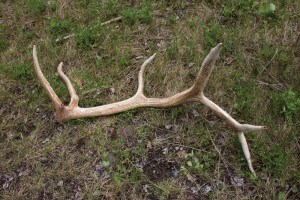
Spring has sprung in Jasper National Park. Flowers are starting to emerge, bears and other wildlife have been observed, and it is becoming greener by the day.
This is the time of year when animals like elk drop their antlers on the valley floor. And as more and more people are catching spring fever and hitting the trails and sites, it is inevitable that some people will discover these treasures.
Discovering antlers can be thrilling, especially if they are from a large or unusual specimen. However, within the national park antlers are protected by law and have an even greater value in their natural setting. This ensures that they not only remain for other adventurers to discover, but that they also remain as an important part of Jasper’s ecosystem as antlers provide an important source of minerals for many small animals.
While antlers have monetary value–as they can be used in jewelry, crafts or decorations– trying to profit by removing them from the park can result in severe fines and even jail time. This includes simply finding an antler and taking it home. So this season remember to leave the antlers where you find them.
When in doubt, go find out. Park Wardens are here to assist you. They work with the RCMP and Jasper Bylaw officers to ensure the safety of people and the environment. Laws are in place for everyone’s safety and for the protection of this valuable place. Canada's National Parks are treasured spaces. With your participation, you can help contribute to the protection of this park and help prevent poaching incidents.
Did you know? Deer have antlers that grow, fall off and re-grow annually. In the spring, the males grow antlers that develop encased within a soft, fury coating called velvet. In the fall–once their antlers have fully grown–the velvet rubs off and they use their new antlers to prove their dominance over other males. In the case of caribou, both the males and females grow antlers.
Unlike the antlers of the deer family, sheep and goats grow permanent horns. These horns grow a bit bigger every year and are also used to establish dominance over other males.
Remember, if you see antlers or horns on the trails leave them in place and if you see anything out of the ordinary call Parks Canada at 780-852-6155 or email [email protected]. For more information on Jasper National Park regulations, visit http://www.pc.gc.ca/jasper.
Correction: The email provided in last week's National Park 51���� about improvement notices within the Park was incorrect. The correct address is: [email protected] Parks Canada apologizes for the error and any confusion it has caused. Thanks to the 51���� and your readership for bringing it to our attention.
Parks Canada
Special to the 51����
